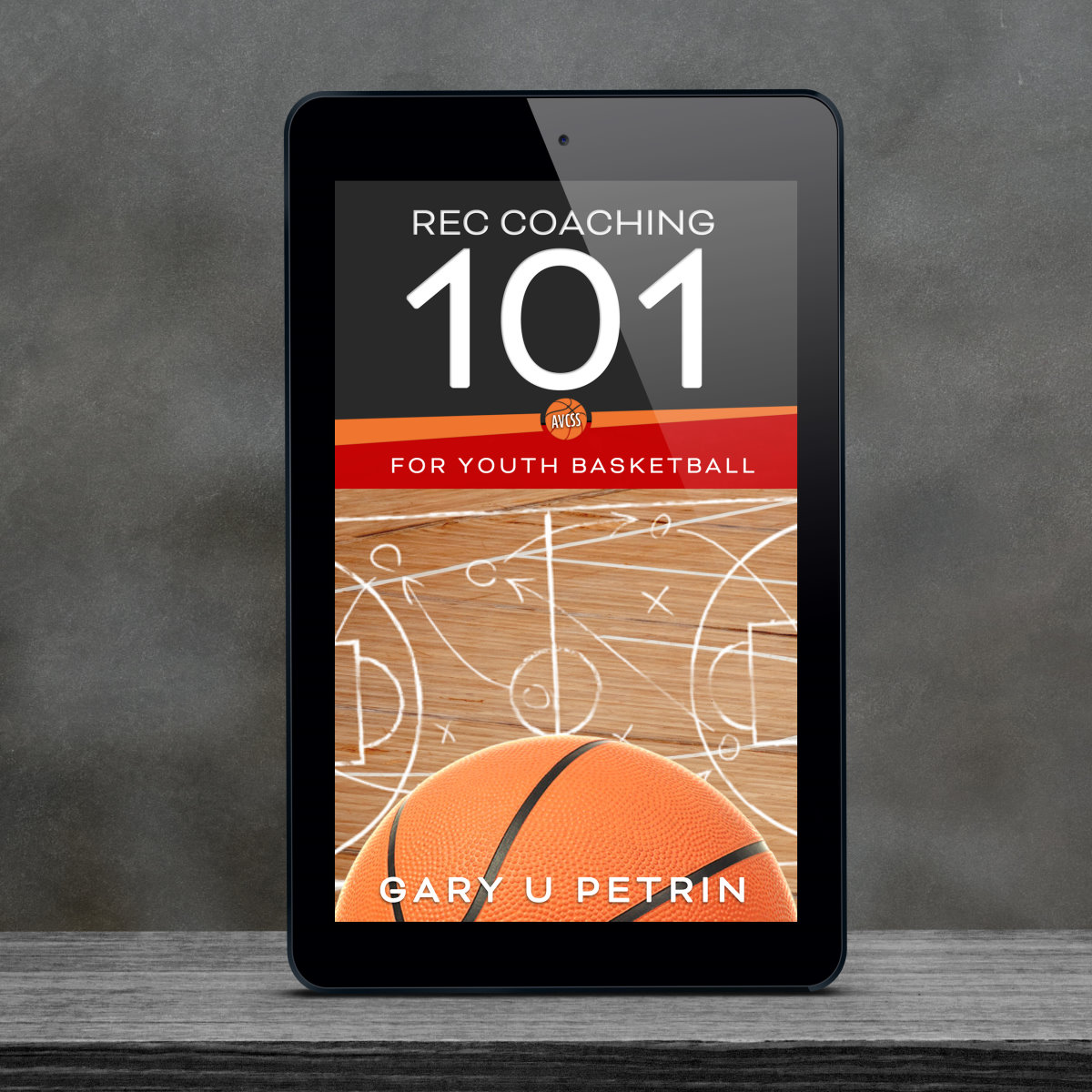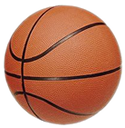 |
 |
 |
Rec Coaching 101 – The Basics
This Rec Coaching 101 Basics menu page is geared toward novice coaches. Those who have never coached before, but would like to give it a try – or coaches that just need a review of the basics and fundamentals to teach basketball drills to kids. We will cover basic basketball plays, defense, drills, paperwork, handouts, and more. This website is here to assist any novice coach that is willing to volunteer their time with teaching beginning basketball to the youth of our communities. It is our volunteers that are the most “critical” aspect in providing opportunity for youth sports development.
Once you read the information on this page and decide you need more – Check out our new download “Recreational Coaching 101 – The Very Basics”. This “Interactive” Booklet covers everything you need to be a successful coach at the recreational level (and more).
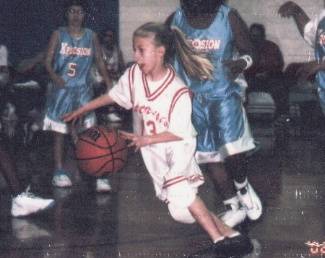
A Review of some of the Basics
Dribbling: Bouncing the ball with the fingertips (not a slapping motion), and most importantly – players should try to always look up while dribbling the basketball.
Passing: There are different types of passes that players can use: Bounce pass, Chest pass, and the Overhead pass are the most used passes in recreational basketball.
Catching the Ball: One of the most basic skills that the younger players lack is catching the ball. Make sure your players keep their eye on the ball, “look the ball” into their hands, and use both hands to firmly catch the ball.
Shooting: There are different types of shots in basketball: The Jump Shot, Lay-Up, 3-Point Shot, and the Free Throw. The 3-point shot is sometimes not used in recreational leagues (especially with the younger teams).
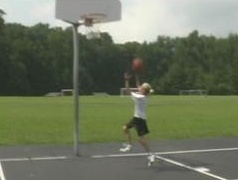
Basic Layup
Developing the Right Hand Lay Up - The Steps
Defense: The team without possession of the ball. The main job of the defense is to keep the other team from scoring points.
Offense: The team with possession of the ball trying to score points (2-points per shot, 1 point for each free throw).
Rebounding: Getting the ball after a shot is taken and missed, there are “offensive” and “defensive” rebounds.
Rebounding Basics (Right Side)
Boxing Out: Is a technique for getting in position against other players to secure a rebound. As the shot is in the air, players should “Box Out” to keep the other team from getting the rebound.
Boxing Out Basics (Right Side)
Turn-Overs: The act of a player losing the basketball. Turn-Overs can be either “Forced” (the player lost the ball due to a defender pressuring the ball) or “Unforced” (the player lost the ball on their own – made a bad pass, dribbled off their foot, etc).
The Basketball Court – Handout:
Take a look at this court diagram and familiarize yourself with the different areas of the court. The more you know about the court, the more you can teach your players. In fact, if you are going to coach a younger team, it is very important that you teach them a few court basics as well as basketball drills for kids– such as the paint area, the elbow, the free throw line, the block, and the baseline.
Basketball Court Diagram – Menu Page
Basketball Glossary (with Diagrams)
Any novice coach can benefit from our Glossary – it’s packed with tons of basketball information from A to Z! A great reference tool for any coach (feel free to download the file, print it out, etc). Check it out…
Free Basketball Glossary – Menu Page
Player Positions
Guards – Usually the smaller, faster players, good ball handlers.
Point Guards – The best ball handler on the team, the play maker (the quarterback).
Forwards – Usually players who are bigger, more athletic, and aggressive.
Centers – Usually the tallest player on the team plays in the middle and down low (in the post area).
Plays – Gotta Have Them!
Keeping the players structured on the court!
Plays are basically a “form/pattern” that you want the players to follow to make sure they are going to go where you want them to go – and when they need to be there. Without structured plays, there would certainly be chaos on the court. There are basketball drills for kids regarding defense, in-bounding the ball, as well as offense.
Types of Defenses:
There are many types of defenses, but most recreational teams will usually only learn a couple of defensive plays at the most – depending on the age group.
- Zone Defense: Players guard areas rather than the person with the ball (easy to learn).
- Man to Man Defense: Players guard other players “1 on 1,” and stay with that player while the other team has the ball (more difficult to learn and teach at the younger ages).
- Pressing: This is when the team plays full court defense, trying to steal the ball anywhere and everywhere on the court (hard to learn, but the players love to press). In some recreational leagues the younger teams are not allowed to press.
We recommend that coaches of the younger rec teams start off with this basic zone defense, it is very easy to teach, and very easy for the players to learn. Start with this basic zone defense, and then move on to something more advanced if you feel the players will be able to execute it properly.
2-1-2 Zone Defense for Youth Rec Teams
Types of Offenses:
There are many types of offenses, but most recreational teams will usually only learn a couple of offensive plays at the most – also depending on the age group.
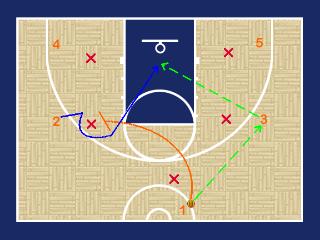
- Zone Offense: Typically run against a Zone defense. Lots of passing, need lots of patience.
- Motion Offense: This offense is used against “Man-to-Man” defense (fairly hard to learn).
- Press Breaking: Used when the other team is “pressing” full court and are trying to steal the ball anywhere and everywhere on the court.
- Inbounds Plays: When the ball goes out of bounds these are plays set up to get the ball in safely and attempt to get an easy basket.
We recommend that coaches of the younger rec teams start off with this basic zone offense, it is very easy to teach, and very easy for the players to learn. Start with this basic zone offense, and then move on to something more advanced if you feel the players will be able to execute it properly.
Basic Zone Offense for Youth Rec Teams
Notes / Teaching Points on Dribbling the Basketball
a) Always stress to the players to “look up” while dribbling and/or while doing ball handling drills. Once you teach your players the basic ball handling drills – try teaching them a basic “Cross-Over” dribbling drill.
Crossover / Basic (stationary)
b) Left Hand – It is very important that younger players start using their left hand to dribble the basketball (their right hand if they are normally left handed). Note: Do not expect miracles from the younger players when it comes to dribbling with their left hand. Be patient, but keep stressing to your players to work hard with their left hand dribbling.
c) Dribble Hard and Low – Coaches should require that all their players dribble “hard and low” at all times. This will ensure that the players will not develop bad habits with their ball handling.
d) Stay under Control – Players should never try to dribble faster than they are able to, and always stay under control. Players will tend to try to race the other players during the dribbling drills, and will lose the ball quite frequently. Players should dribble as fast as they can while staying under control. Coaches must enforce this very important rule of dribbling the basketball.
e) Dribbling Glasses – if you get the chance to introduce this dribbling aide to players, it would be very helpful. These glasses force the players to look up while dribbling, and are designed to keep players from being able to look down.

Key Teaching Points – Defense
1. Protect the area under the basket; keep the other team from scoring easily in the “Paint” area.
2. All players should be able to play defense! Players should always stay low and move their feet (always use the proper defensive stance).
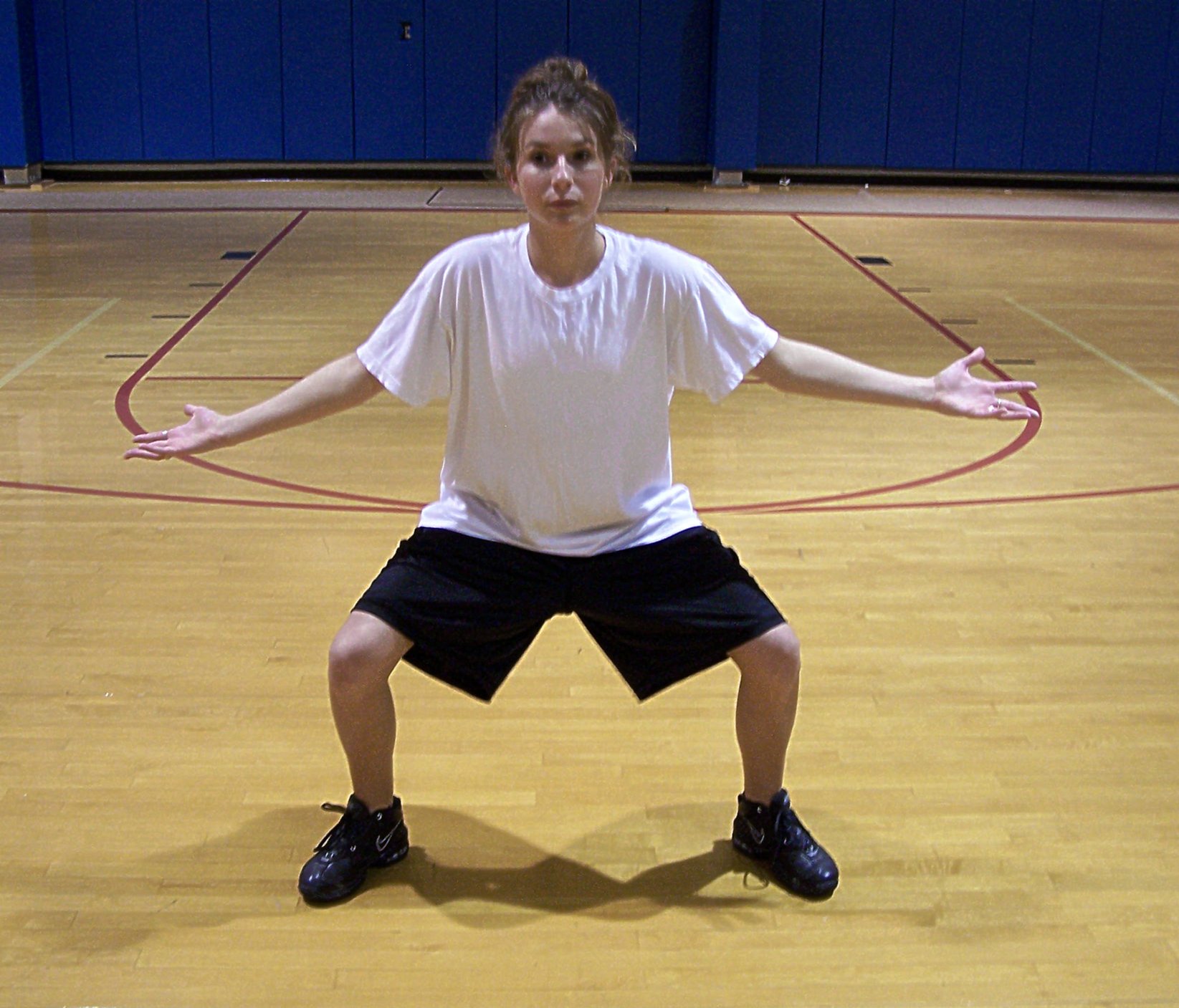 Basic Defensive Stance
Basic Defensive Stance
3. Teach the players to be aggressive and to always hustle when playing defense.
4. Players should not stand still on defense, defenders must move every time the ball is passed.
5. Players should not “slap” and/or “reach in” when playing defense (this causes too many fouls).
6. If one player does not “move” or “run” to the ball on the pass, the other team could have an opening for an easy basket.
Recreational Basketball
A philosophy and opinion:
Most recreational basketball leagues are set up to have fun while learning the sport of basketball. There’s usually no standings or records of wins and losses kept. Although this may not be the case in some of the larger cities, there are usually no championship games at the end of the season. The level of playing ability is usually really low with some exceptions of course. As a recreational coach you must ensure that your team understands that winning is not as important as learning new skills and having fun. Basketball is a game, plain and simple, and it’s up to the coach’s to make it a great experience for each player on the team. Teaching basketball drills for kids will be a very rewarding experience.
Even Rec Games can get out of control
As a coach of recreational basketball for over 12 years I have experienced many things that should not have occurred during a rec game. Coaches screaming at players, parents yelling at the referees, coaches yelling at the referees, coaches arguing with each other, and parents screaming at their kids on the court and worst of all – after the games. At this level the players just want to learn rec coaching basics, have fun, and play the game of basketball. Coaches must remember that the main goal of the program is teaching basketball drills for kids, developing skills, and good sportsmanship!
Again, we could not possibly cover everything there is to know about coaching rec basketball on one section of this Rec Coaching Basics / Basketball Drills for kids webpage, but we tried. The new download AVCSS Basketball publication “Recreational Coaching 101 – The Very Basics” will take you step by step through the process – packed with video clips, forms to use, diagrams, pictures, and much more (can’t beat this price for this much information).
More information on Rec Coaching 101
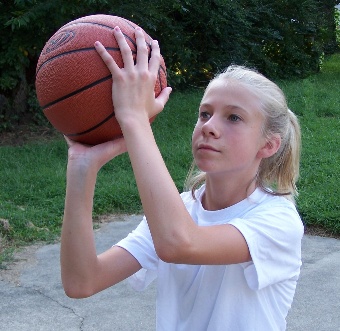
What’s covered in Recreational Coaching 101?
- Passing / Catching Basics.
- Shooting Basics (form, jump shot, lay-up, and the free throw).
- Defense Basics (stance, step slide, hand movement, fouls).
- Starting the Team – The first steps.
- Planning the First Practices / Sample practice plan.
- Basic Skill Development / Skills and Drills.
- Running your practices.
- The 2-1-2, A very popular Zone Defense.
- A very popular Zone Offense.
- A very simple Inbounds Play to use.
- The Game – Game notes and basics, rules, substitution form, and much more…
Get your copy now – Recreational Coaching “101” – CLICK HERE!
Basketball Drills for Kids
All the Rec Coaching Handouts in one place
Check out our Youth Basketball Glossary Here
